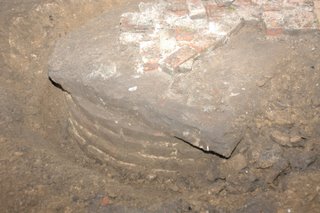“Yellow! Did you say yellow?”
“Well, not exactly yellow. It’s more of a brownish, subdued, goldish, kind of yellow,” I replied.
“But I like it just how it looks now,” she said, her disappointment clear on her face and in her voice.
This conversation was just one of many I have had regarding the work currently underway at the Aiken-Rhett House, funded by the Save America's Treasures grant. And I have to admit, I also love the current weathered patina of the house’s exterior. So when I first heard of the plans to limewash the building, I was not enthused about it. It’s perfectly fine for old buildings to look their age and the thought of putting a fresh coat of paint on such a Grand Dame didn’t set well with a lot of people, me included…at least not at first.
There were a couple of factors that changed my mind and eased my reservations. First, our architect Glenn Keyes and our contractor Moby Marks explained to me the finer points of limewashing. Limewash is not paint per se; it’s the very top coat of exterior stucco. Since it is lime based, it bonds to the masonry below it and helps create a protective yet permeable outer coating.
Prior to beginning the Aiken-Rhett House’s limewashing, Glenn took me around Charleston to look at limewashed buildings. I began to see the beauty of a historically correct limewash. Limewash colors maintain their vibrancy yet they have a depth to them you just can’t get from modern paints. A limewashed wall has a kind of a mottled look, which is the inescapable result of limewash’s water-like consistency. It has to be applied in multiple coats with a stiff bristle brush. And since you can add pigments to it, we get to debate things like “how yellow” the yellow is.
Enter historic paint specialist Susan Buck. Susan has been working on understanding the paint sequences at the Aiken-Rhett House for years. She took an X-acto knife and sliced a tiny bit of paint off the wall and examined it under a microscope. (If you’ve never seen a microscopic cross-section of a paint sample, picture a slice of eight-layer cake with red, green, white, brown, and yellow icing alternating between the layers.) With this sample, Susan was able to determine that the house was limewashed multiple times. Her identification of the correct yellow came as, admittedly, a bit of an aesthetic shock to me once I saw a color match sample put on the house’s wall.
But I was finally able to appreciate the aesthetic changes to the Aiken-Rhett House once I understood the building’s limewash and color history and the need to put the top coat on the stucco. It sounds oxymoronic, but a newly limewashed wall has an aged look. So, for those not happy with new/old color, you won’t have to wait another hundred years to see the patina we appreciate now.




